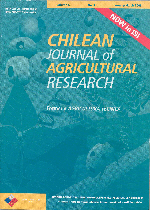
|
Agricultura Técnica
Instituto de Investigaciones Agropecuarias, INIA
ISSN: 0365-2807
EISSN: 0365-2807
Vol. 61, No. 3, 2001, pp. 294-305
|
 Bioline Code: at01032
Bioline Code: at01032
Full paper language: Spanish
Document type: Research Article
Document available free of charge
|
|
|
Agricultura Técnica, Vol. 61, No. 3, 2001, pp. 294-305
| en |
Wild oat (Avena FatuaL.) and Italian Ryegrass (Lolium MultiflorumLam.) Effect on Wheat Yield at two Locations
Pedreros, Alberto L.
Abstract
Two experiments were conducted, through additive design,
to evaluate the effect of increasing densities of wild oats (
Avena fatua
) and Italian ryegrass (
Lolium multiflorum
), separately, on winter and spring production of wheat (
Triticum aestivum
L.) at two locations in Chile. Wild oat densities between 0 to 16 plants
m
-2
in the Andean foothills, and 0 to 24 plants m
-2
in the irrigated valley, and Italian ryegrass densities between 0 to 50
plants m
-2
in the Andean foothills, and 0 to 80 plants m
-2
the irrigated valley were used. A hyperbolic model was fitted to the data
to predict wheat yield and loss. Every additional wild oat plant m
-2
reduced wheat yield by approximately 100 kg ha
-1
, while every additional 10 Italian ryegrass plants m
-2
reduced wheat yield about 140 to 200 kg ha
-1
. Wild oat densities of 3 plants m
-2
reduced wheat yield by 4.5% in the irrigated valley, and 3.5% in the Andean
foothills, respectively. Italian ryegrass densities of 10 plants m
-2
reduced wheat yield by 1.6% at the irrigated valley and by 1.3% at Andean
foothills, respectively. With the losses projected by the hyperbolic model,
the economic threshold varied between 3 and 4.4 wild oat plants m
-2
, and 27 and 36 Italian ryegrass plants m
-2
depending on the agroecological area and weed control cost. There was a
linear relationship between the number of uncontrolled weeds and the density
of weed seeds in the wheat. The largest wild oat density of 24 plants m
-2
increased the soil seed bank by 2,000 seeds m
-2
, while the largest Italian ryegrass density of 80 plants m
-2
increased the soil seed bank by more than 28,000 seeds m
-2
.
Keywords
Interference, economic threshold, seed production, weeds, AVEFA, LOLMU
|
| |
| es |
Efecto de Avenilla (Avena FatuaL.) y Ballica (Lolium MultiflorumLam.) en el Rendimiento de Trigo en dos Áreas Agroecológicas
Pedreros, Alberto L.
Resumen
Se efectuaron dos ensayos de campo, mediante un diseño
aditivo, para evaluar el efecto de densidades crecientes de avenilla (
Avena fatua
L.) y ballica (
Lolium multiflorum
Lam.), separadamente, en la producción de trigo (
Triticum aestivum
L.) primaveral e invernal en el valle regado y la precordillera de Ñuble,
respectivamente. Las densidades de avenilla fluctuaron entre 0 y 16 plantas
m
-2
en la precordillera andina y entre 0 y 24 plantas m
-2
en el valle regado. En ballica, se utilizaron densidades de 0 a 50 plantas
m
-2
en la precordillera andina y de 0 a 80 plantas m
-2
en el valle regado. Los datos obtenidos se ajustaron a un modelo hiperbólico
para predecir el rendimiento y pérdida en rendimiento. Aumentos de
una planta de avenilla m
-2
significaron, aproximadamente, una pérdida de 100 kg ha
-1
de trigo; mientras que cada 10 plantas de ballicas m
-2
, significaron una pérdida de entre 140 y 200 kg ha
-1
de trigo. Densidades de 3 avenillas m
-2
proyectaron una pérdida en el rendimiento de trigo de 4,5% en el valle
regado y de 3,5% en la precordillera, respectivamente. Densidades de 10
plantas de ballica m
-2
predijeron una pérdida en el rendimiento de trigo de 1,6% en el valle
regado y de 1,3% en la precordillera. Con las pérdidas proyectadas
por el modelo hiperbólico, el umbral económico varió entre
3 y 4,4 plantas de avenilla m
-2
y 27 y 36 plantas de ballica m
-2
, dependiendo del área agroecológica y del costo del control.
Hubo una respuesta lineal a la densidad de cada maleza para producir semillas
por plantas no controladas en el cultivo de trigo. La mayor densidad de
avenilla, 24 plantas m
-2
, incrementó el reservorio en el suelo en casi 2000 semillas m
-2
, mientras que la mayor densidad de ballica, 80 plantas m
-2
, lo hizo en más de 28.000 semillas m
-2
.
Palabras-clave
I Interferencia, umbral económico, producción de semillas, malezas, AVEFA, LOLMU
|
| |
© Copyright 2001 - Instituto de Investigaciones Agropecuarias, INIA (Chile)
Alternative site location: http://www.inia.cl/at/agritec.htm
|
|
